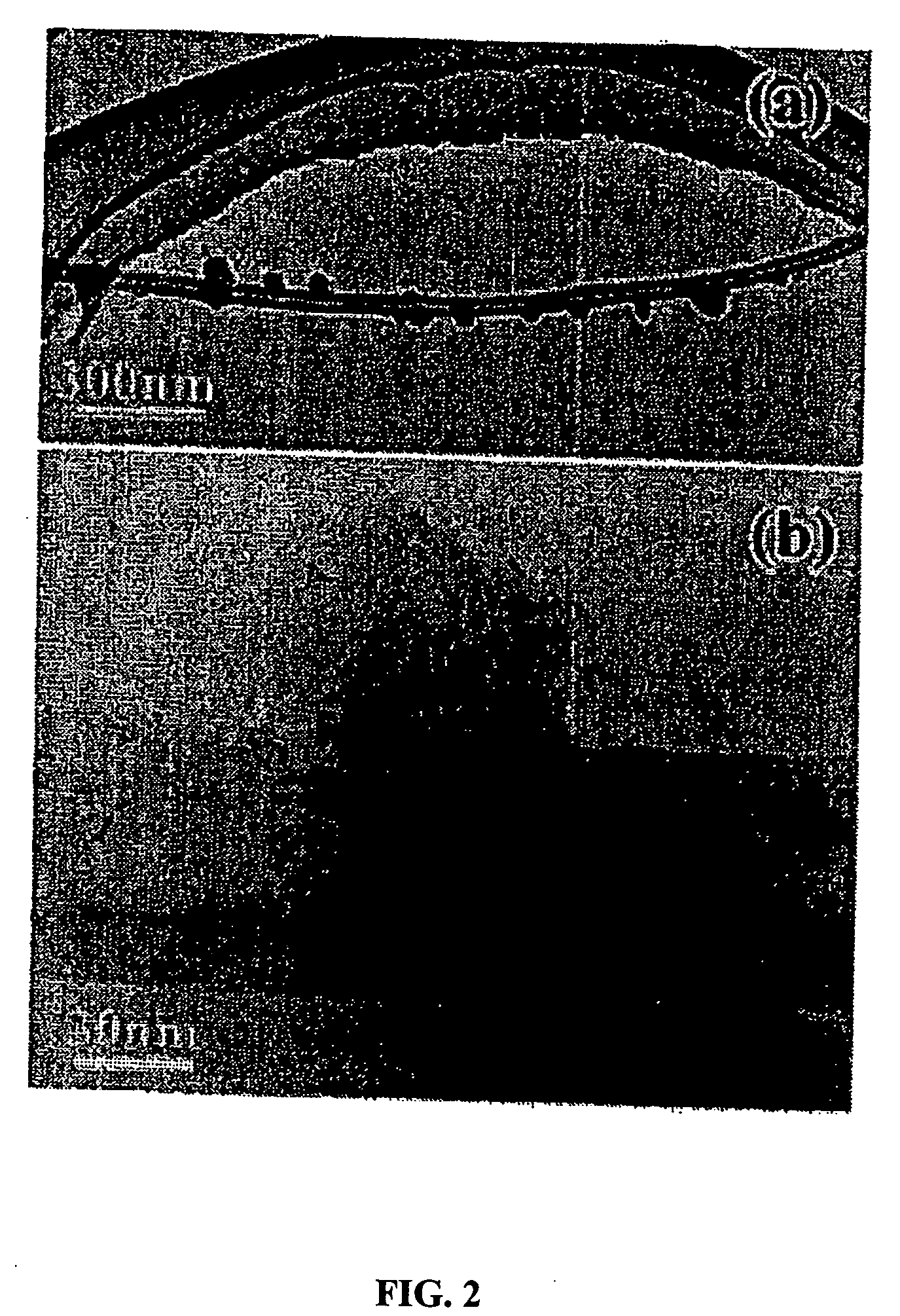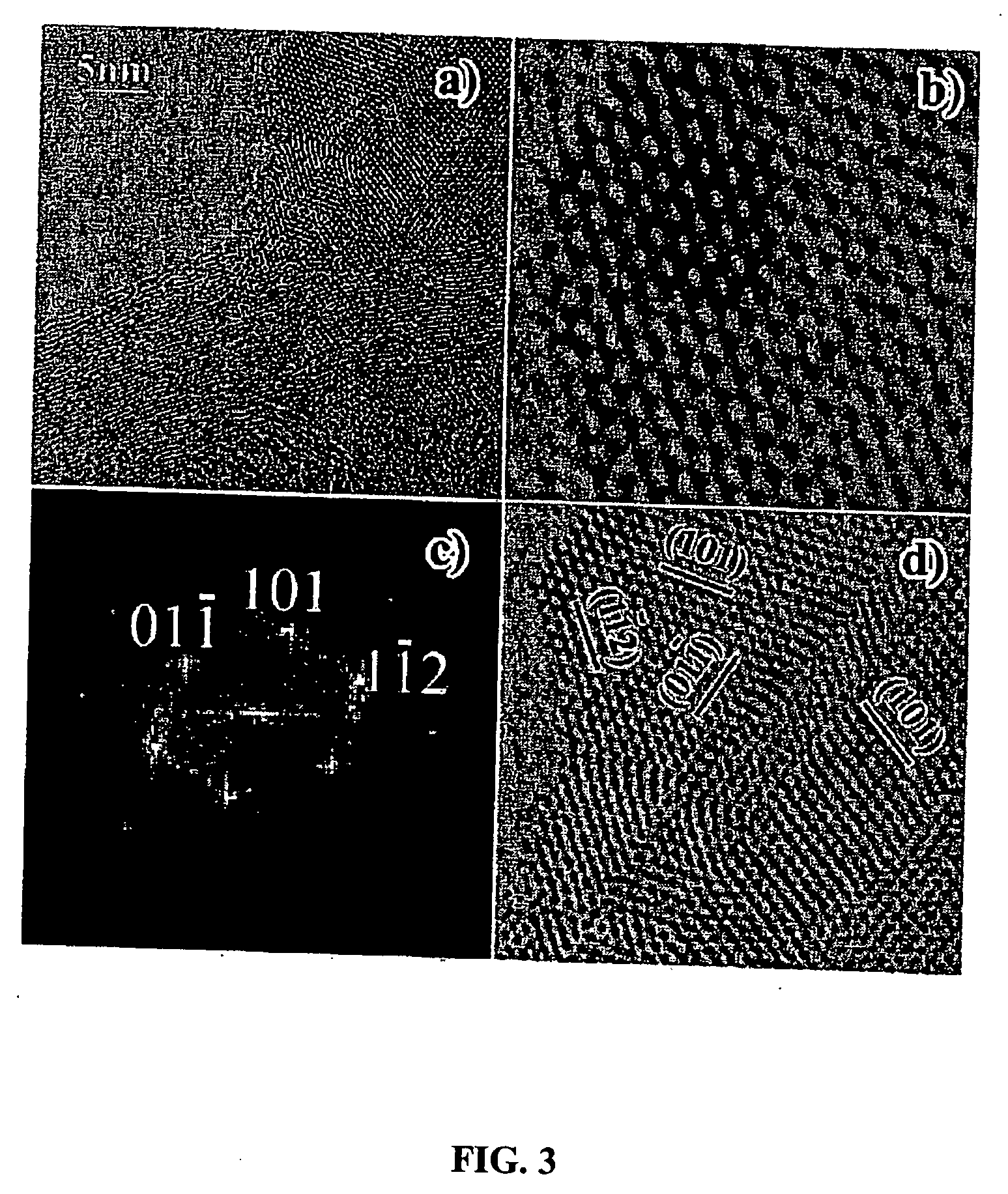Synthesis of boron carbide nanoparticles
a technology of boron carbide nanoparticles and nanoparticles, which is applied in the field of reinforced carbon nanotubes, can solve the problems of reduced load bearing ability, failure mechanism of “sword-in-sheath” type, and no significant improvement in mechanical properties after such modification, and achieves improved mechanical properties and high strength
- Summary
- Abstract
- Description
- Claims
- Application Information
AI Technical Summary
Benefits of technology
Problems solved by technology
Method used
Image
Examples
example 1
B4C Nanoparticles Formed by a Reaction of Boron from Thermal Decomposition of MgB2 with CNTs Yielding Large Quantities of B4C Nanoparticles
[0080] In one embodiment of the present invention, reinforced CNTs are produced through the thermal decomposition of MgB2. In one embodiment, a large quantity of boron carbide (B4C nanoparticles) can be produced on CNTs wherein the CNTs are multi-walled and of a bambo-like morphology.
[0081] Boron carbide (B4C) can be prepared by several methods, such as carbonthermal route of boron oxide (B2O3, H3BO3, Na2B3O7, etc.), reduction of BCl3 by CH4 at a temperature of about 1500° C. with laser, direct reaction of carbon with boron, magnesiothermic reduction of B2O3 in the presence of carbon at about 1000-1200° C. The industrial method to grow B4C is carbon-thermal reduction of boric acid at a temperature over 2000° C. At low temperature (about 450° C.), B4C nanoparticles can be made by using BBr3 and CCl4 as the reactants and metallic Na as the co-re...
example 2
Ratio of Boron to Carbon; Effect on Physical Properties
[0094] In one embodiment of the invention, adjusting the boron to carbon ratio (B:C) was seen to improve the physical properties of the reinforced CNTs; additionally, in one embodiment, the use of a plasma pressure compact device was seen to improve the physical properties of the reinforced CNTs.
[0095] B4C particles of approximately 100 nm size were synthesized through reaction of MgB2 with multiwall carbon nanotubes (MWCNTs). The mixture of MgB2 and MWCNTs were heated to 1150° C. and kept for 2 hrs under a pressure of 10−2 Torr. Different ratio of starting materials can produce either B4C-rich or CNTs-rich sample. Scanning electron microscopy (SEM) images show the uniform dispersion of B4C among CNTs after reaction (see FIG. 20).
[0096] X-ray diffraction (XRD)(see FIG. 21) shows the sample mainly contains B4C and CNTs. Clean boundaries, possibly indicating strong covalent bonds between B4C and CNTs, can be observed from tran...
example 3
Synthesis of Reinforced CNTs having Boron Carbide (BxCy) Nanolumps Formed Substantially on the Surface of the CNTs
[0102] The multi-wall CNTs were grown by catalytic chemical vapor deposition method (see Li, et al., Appl. Phys. A: Mater. Sci. Process, 73, 259 (2001), the contents of which is incorporated herein by reference in its entirety) and purified by hydrofluoric acid (HF). Magnesium diboride (MgB2), a new superconducting material, is used as the source of boron. The synthesis of magnesium diboride (MgB2) can be synthesized by combining elemental magnesium and boron in a sealed (Ta) tube in a stoichiometric ratio and sealed in a quartz ampule, placed in a box furnace at a temperature of about 950° C. for about 2 hours. Powder MgB2 with average grain size of about 1 micrometer decomposes at a temperature of about 600° C. Thermally decomposed boron is more chemically reactive so the solid-state reaction can be performed at relatively low temperatures. The nanotubes were mixed g...
PUM
| Property | Measurement | Unit |
|---|---|---|
| Fraction | aaaaa | aaaaa |
| Fraction | aaaaa | aaaaa |
| Fraction | aaaaa | aaaaa |
Abstract
Description
Claims
Application Information
 Login to View More
Login to View More - R&D
- Intellectual Property
- Life Sciences
- Materials
- Tech Scout
- Unparalleled Data Quality
- Higher Quality Content
- 60% Fewer Hallucinations
Browse by: Latest US Patents, China's latest patents, Technical Efficacy Thesaurus, Application Domain, Technology Topic, Popular Technical Reports.
© 2025 PatSnap. All rights reserved.Legal|Privacy policy|Modern Slavery Act Transparency Statement|Sitemap|About US| Contact US: help@patsnap.com



